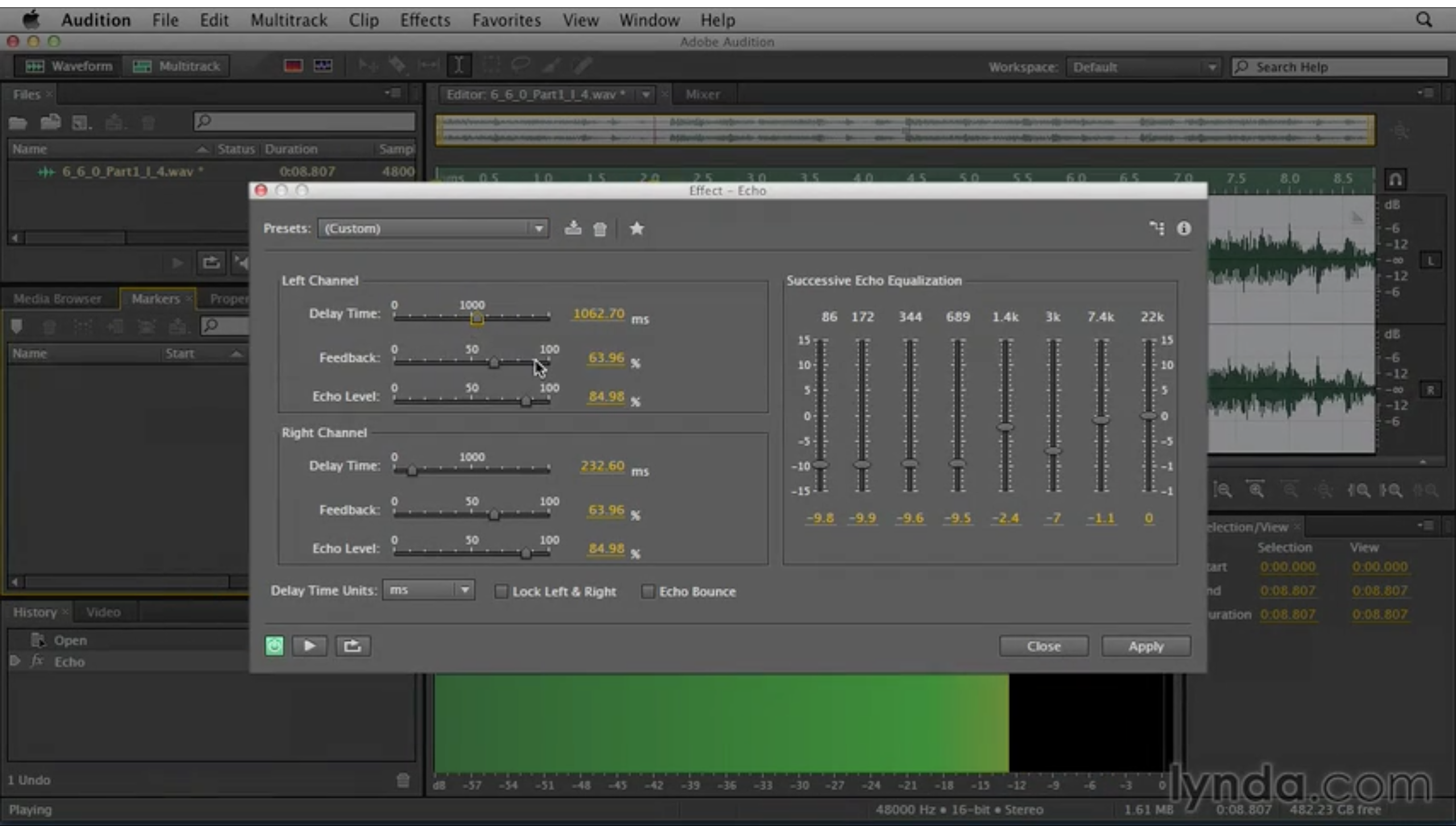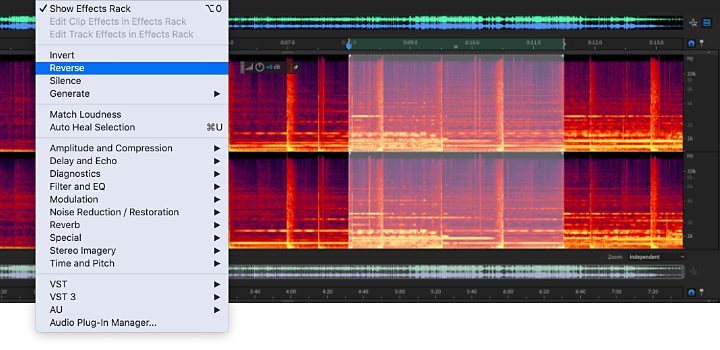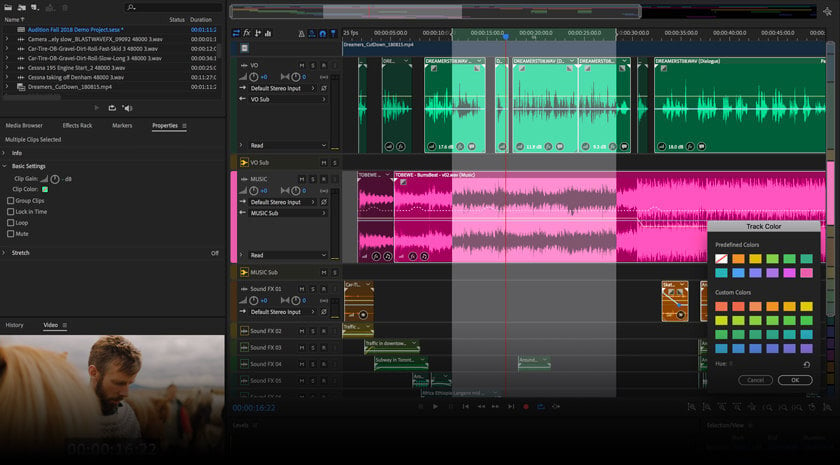Adobe Audition can turn any computer into a complete digital audio workstation. It offers an editing environment aimed at working with individual files and a multitrack editing system, where it is possible to mix files from different sound sources in order to add them to a given timeline. VOICE + TEXT.THANKS FOR 500 LIKES ♥. Get into a new Way of Learning Adobe Audition CC. Audition CC tutorial for beginners, getting started, basics.The. Edit, mix, record, and restore audio. Audition is a comprehensive toolset that includes multitrack, waveform, and spectral display for creating, mixing, editing, and restoring audio content. This powerful audio workstation is designed to accelerate video production workflows and audio finishing — and deliver a polished mix with pristine sound. Adobe Help Center. Overview of Adobe Audition CS6 workspace 2. How to record narration 3. How to edit audio tracks 4. How to compose multiple track recordings 5. How to work with audio 6. How to apply Adobe Audition sound effects 7. How to use loops, music beds, and sound effects. Key terms: audition cs6, audio production.
Register your product to gain access to bonus material or receive a coupon.
- By Adobe Creative Team, Adobe Creative Team
- Published Jun 18, 2013 by Adobe Press.
Book

- Sorry, this book is no longer in print.
eBook (Watermarked)
- Your Price: $41.59
- List Price: $51.99
- Includes EPUB, MOBI, and PDF
This eBook includes the following formats, accessible from your Account page after purchase:
EPUBThe open industry format known for its reflowable content and usability on supported mobile devices.
MOBIThe eBook format compatible with the Amazon Kindle and Amazon Kindle applications.
PDFThe popular standard, used most often with the free Adobe® Reader® software.
This eBook requires no passwords or activation to read. We customize your eBook by discreetly watermarking it with your name, making it uniquely yours.
- Copyright 2013
- Dimensions: 7-3/8' x 9-1/8'
- Pages: 304
- Edition: 1st
- Book
- ISBN-10: 0-321-92953-5
- ISBN-13: 978-0-321-92953-2
The fastest, easiest, most comprehensive way to learn Adobe Audition CC
Classroom in a Book®, the best-selling series of hands-on software training workbooks, offers what no other book or training program does—an official training series from Adobe Systems Incorporated, developed with the support of Adobe product experts.
Adobe Audition CC Classroom in a Book contains 15 lessons (and one bonus lesson on www.peachpit.com) that cover the basics, providing countless tips and techniques to help you become more productive with the program. You can follow the book from start to finish or choose only those lessons that interest you.
Purchasing this book gives you access to the downloadable lesson files you need to work through the projects in the book, and to electronic book updates covering new features that Adobe releases for Creative Cloud customers. For
access, go to www.peachpit.com/redeem and redeem the unique code provided inside this book.
“The Classroom in a Book series is by far the best training material on the market. Everything you need to master the software is included: clear explanations of each lesson, step-bystep instructions, and the project files forthe students.”
Barbara Binder,
Adobe Certified Instructor
Rocky Mountain Training
Online Sample Chapter
Excerpt
Sample Pages
Table of Contents
PART 1: INTRODUCTION
Chapter 1: Audio interfacing
Audio interface basics
Mac OS X audio setup
Adobe Audition For Dummies Full
Windows setup
Audio channel mapping
Testing the audio setup
Using external audio interfaces
Chapter 2: The Audition environment
Waveform vs. Multitrack views

The Audition workspace
Navigation
PART 2: WAVEFORM VIEW
Chapter 3: Basic Editing
Opening files
Selecting regions and changing levels
Non-linear editing
Chapter 4: Signal processing
The effects rack
Amplitude and Compression
Delay and Echo effects
Filter and EQ effects
Modulation effects
Reverb effects
Special effects
Multi-effects
Stereo imaging
Time and Pitch effects
Using third-party VST and AU effects

Using the effects menu
Managing effects presets
Chapter 5: Audio Restoration
Reducing hiss via Noise Reduction
Click/pop eliminator
Reducing broadband noise
DeHummer
Removing artifacts with the spectral display
Chapter 6: Mastering
Mastering basics
Applying EQ
Applying dynamics
Applying ambience
Enhancing the stereo image
Altering amplitude
File conversion
Analysis
Chapter 7: Sound design
Special effects
Pushing the envelope of processing
Chapter 8: Creating and recording files
Recording into the Waveform Editor
Recording into the Multitrack Editor
Drag and Drop into an Audition Editor
Importing Audio from CDs
Saving Templates
PART 3: MULTITRACK VIEW
Chapter 9: Basic multitrack orientation
About Multitrack production
Commonalities with waveform view and integration between the two
Looped playback
Track controls
Track areas
Channel mapping
Side-chaining effects
Chapter 10: The Multitrack Mixer View
Mixer view basics
Using hardware controller
Adobe Audition For Dummies 2020
Mixer customization via show/hide options
Channel scrolling
Chapter 11: Editing Clips
Crossfading
Mixing or exporting a collection of clips
Fitting to specific durations
Basic clip automation
Add effects to individual clips
Extend a clip via looping
Chapter 12: Creating music with sound libraries
About Sound Libraries
Building a rhythm track
Adding percussion
Adding melodic elements
Matching tempo among disparate loops
Matching pitch among disparate loops
Adding processing
Chapter 13: Recording in the Multitrack Editor
Multitrack recording

Getting ready to record a track
Setting up the metronome and the metronome track
Recording a part in a track
Recording an additional part (overdubbing)
Punching in over a mistake
Composite recording
Chapter 14: Automation
About automation
Advanced clip automation
Track automation
Chapter 15: Mixing strategies
About Mixing
The Mixing Process
Publishing
Chapter 16: Working with Video
Importing video into Audition
Automatic speech alignment
Other Things You Might Like
- Adobe Audition CC Classroom in a Book, 2nd Edition
- Book $47.99
- Adobe Audition CC Classroom in a Book, 2nd Edition
- eBook (Watermarked) $38.39
- Adobe Audition CC Classroom in a Book (Web Edition)
- Web Edition $38.39
